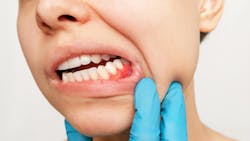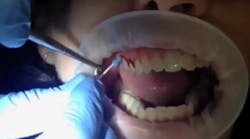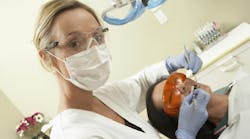We’ve heard the commercial about a little pink in the sink telling patients that it’s a sign of gingivitis. It is, yet it’s also easy to ignore the pink, even for clinicians. Often, we minimize or overlook bleeding at a patient’s preventive maintenance appointment. Whether it is bleeding upon probing or that gush of delayed bleeding while scaling, it needs our attention.
Why bleeding matters
Gingival bleeding is the objective clinical sign we typically use to determine if inflammation is present. While patients with smoking or vaping habits may have suppressed bleeding, or those on blood thinners might have increased bleeding, generally, gathering a patient’s bleeding index is a valuable assessment tool to document the activity of disease present.
The observation of gingival bleeding demonstrates ulceration of the sulcular epithelium. This means there is a chronic oral wound in the pocket. These wounds fail to heal in a normal time frame and remain open, weeping sores that can lead to further oral and systemic complications. Can you imagine the urgency with which we’d treat these infected lesions if they weren’t hiding in a pocket?
How to assess bleeding
Traditionally, we have recorded bleeding sites while probing. While I still recommend recording this index as it elicits a response from the base of the pocket, another technique utilizes stimulation. Before any instrumentation has occurred, the patient takes an interdental aid or soft toothpick and places it interproximally, stimulating the lining of the sulcus. This is sometimes referred to as the papillary bleeding index or sucular sweep.1 One advantage to this technique is that the patient can see how easily their gums bleed without the clinician poking them!
Different kinds of bleeding
It only takes a few patients before a clinician realizes that bleeding can vary from patient to patient, both in severity and when it appears. Spontaneous bleeding can occur without much stimulation and is often an indicator of advanced periodontal disease and/or underlying health conditions. Pinpoint bleeding, while more localized, can indicate early-stage gum disease or a localized infection. Delayed bleeding happens after you’ve moved on to another tooth or even later in the appointment. This is often an indicator of deeper sulcular inflammation or tissue damage.
I’ve always been fascinated by patients with very little bleeding upon probing or stimulation but who gush upon instrumentation. In this case, we need to look at more than just the presence of bleeding; we must also consider its quality and concentration. Heavy, deep red, profuse, or prolonged bleeding may indicate more severe inflammation or underlying conditions.
What to do
Traditionally, we treat bleeding with instrumentation, removing the deposits, and disrupting the biofilm. But if you’ve been in practice for a minute, you know it doesn’t reliably work. Incorporating adjuncts that alter the oral microbiome to allow for healing could be the trick to decreasing or eliminating bleeding. In-office therapies such as subgingival air polishing with a low abrasive powder, lasers, and desiccants may help reach more sites. Home therapies such as water flossers, povidone-iodine, and Perio Tray Therapy utilizing an FDA-cleared tray to deliver a 1.7% hydrogen peroxide solution below the gumline are worth investigating.
Implement a gum score based on a simple number
When there is bleeding, the patient is not healthy. We could debate prophy versus gingivitis versus perio for days. Or get all confused over the AAP staging and grading. But the simple truth is that healthy gums don’t bleed. When we observe bleeding, we need to treat it. Sometimes this shift is challenging because we have tolerated bleeding for so long. All of a sudden, we’re telling patients they have disease as if out of nowhere. But really, we have to do better.
Let’s start talking about infection and inflammation to help patients understand their risks. Create a gum score based on the number of bleeding points. This is a simple number that’s easy for patients to understand. The goal is to have the lowest number possible. Any number below 10—below 10 sites of bleeding—is ideal. When patients have a higher number than 10 sites of bleeding, we recommend treatment to address the infection and inflammation.
This gum score is a great way to give the dental team the confidence to take action and measure progress. It’s a great way to focus our attention on gingival health and stop ignoring the pink.
Start showing patients their bleeding. Give them their gum score and remind them that you will revisit this at the next appointment. Empower them to address their disease at home with more than just the brush-and-floss lecture. Then watch them return with less bleeding and more health!
Reference
- Checchi L, Montevecchi M, Marucci G, Checchi V. A proposed new index for clinical evaluation of interproximal soft tissues: the interdental pressure index. Int J Dent. 2014;2014:345075. doi:10.1155/2014/345075. Erratum in: Int J Dent. 2014;2014:586537. doi:10.1155/2014/586537
About the Author

Amanda Hill, BSDH, RDH, CDIPC
Amanda Hill, BSDH, RDH, CDIPC, is an enthusiastic speaker, innovative consultant, and award-winning author who brings over 25 years of clinical dental hygiene and education to dentistry. Recipient of OSAP’s Emerging Infection Control Leader award and an active participant with the advisory board for RDH magazine, DentistryIQ, and OSAP’s Infection Control in Practice Editorial Review Board and membership committee, Amanda (also known as the Waterline Warrior) strives to make topics in dentistry accurate, accessible, and fun. She can be reached at [email protected].


